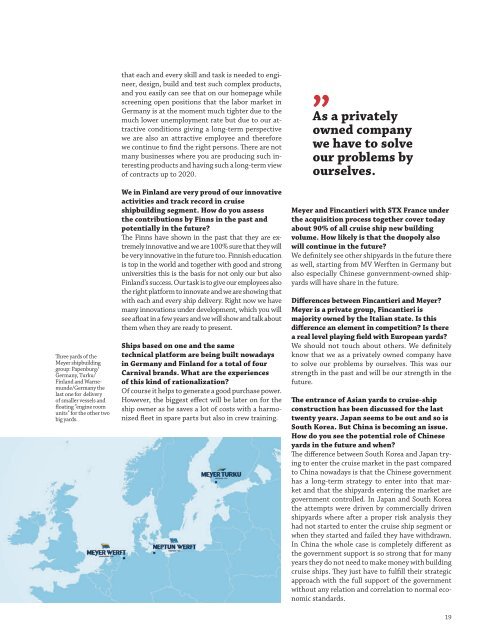You also want an ePaper? Increase the reach of your titles
YUMPU automatically turns print PDFs into web optimized ePapers that Google loves.
Three yards of the<br />
Meyer shipbuilding<br />
group: Papenburg/<br />
Germany, Turku/<br />
Finland and Warnemunde/Germany<br />
the<br />
last one for delivery<br />
of smaller vessels and<br />
floating ”engine room<br />
units" for the other two<br />
big yards.<br />
that each and every skill and task is needed to engineer,<br />
design, build and test such complex products,<br />
and you easily can see that on our homepage while<br />
screening open positions that the labor market in<br />
Germany is at the moment much tighter due to the<br />
much lower unemployment rate but due to our attractive<br />
conditions giving a long-term perspective<br />
we are also an attractive employee and therefore<br />
we continue to find the right persons. There are not<br />
many businesses where you are producing such interesting<br />
products and having such a long-term view<br />
of contracts up to 2020.<br />
We in Finland are very proud of our innovative<br />
activities and track record in cruise<br />
shipbuilding segment. How do you assess<br />
the contributions by Finns in the past and<br />
potentially in the future?<br />
The Finns have shown in the past that they are extremely<br />
innovative and we are 100% sure that they will<br />
be very innovative in the future too. <strong>Finnish</strong> education<br />
is top in the world and together with good and strong<br />
universities this is the basis for not only our but also<br />
Finland’s success. Our task is to give our employees also<br />
the right platform to innovate and we are showing that<br />
with each and every ship delivery. Right now we have<br />
many innovations under development, which you will<br />
see afloat in a few years and we will show and talk about<br />
them when they are ready to present.<br />
Ships based on one and the same<br />
technical platform are being built nowadays<br />
in Germany and Finland for a total of four<br />
Carnival brands. What are the experiences<br />
of this kind of rationalization?<br />
Of course it helps to generate a good purchase power.<br />
However, the biggest effect will be later on for the<br />
ship owner as he saves a lot of costs with a harmonized<br />
fleet in spare parts but also in crew training.<br />
” As a privately<br />
owned company<br />
we have to solve<br />
our problems by<br />
ourselves.<br />
Meyer and Fincantieri with STX France under<br />
the acquisition process together cover today<br />
about 90% of all cruise ship new building<br />
volume. How likely is that the duopoly also<br />
will continue in the future?<br />
We definitely see other shipyards in the future there<br />
as well, starting from MV Werften in Germany but<br />
also especially Chinese gonvernment-owned shipyards<br />
will have share in the future.<br />
Differences between Fincantieri and Meyer?<br />
Meyer is a private group, Fincantieri is<br />
majority owned by the Italian state. Is this<br />
difference an element in competition? Is there<br />
a real level playing field with European yards?<br />
We should not touch about others. We definitely<br />
know that we as a privately owned company have<br />
to solve our problems by ourselves. This was our<br />
strength in the past and will be our strength in the<br />
future.<br />
The entrance of Asian yards to cruise-ship<br />
construction has been discussed for the last<br />
twenty years. Japan seems to be out and so is<br />
South Korea. But China is becoming an issue.<br />
How do you see the potential role of Chinese<br />
yards in the future and when?<br />
The difference between South Korea and Japan trying<br />
to enter the cruise market in the past compared<br />
to China nowadays is that the Chinese government<br />
has a long-term strategy to enter into that market<br />
and that the shipyards entering the market are<br />
government controlled. In Japan and South Korea<br />
the attempts were driven by commercially driven<br />
shipyards where after a proper risk analysis they<br />
had not started to enter the cruise ship segment or<br />
when they started and failed they have withdrawn.<br />
In China the whole case is completely different as<br />
the government support is so strong that for many<br />
years they do not need to make money with building<br />
cruise ships. They just have to fulfill their strategic<br />
approach with the full support of the government<br />
without any relation and correlation to normal economic<br />
standards.<br />
19

















